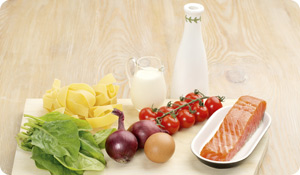
Even a healthy diet can lack significant amounts of essential nutrients, especially since the definition of "healthy" varies from person to person. For any number of reasons—from personal choice to medical necessity—many people eliminate certain foods and even entire food groups from their diets, which can result in potential vitamin and mineral deficiencies.
Nutrient deficiencies will vary from person to person, depending on individual food preferences, age, health status, and other factors. The 2015 Dietary Guidelines Advisory Committee found that a representative sample of Americans over the age of two fell short when it came to a number of nutrients: vitamins A, C, D, E, and folate (a B vitamin); the minerals calcium, magnesium, and potassium; and fiber. The committee also found that adolescent and premenopausal females, including pregnant women, do not consume enough iron.
"Potassium is a good example of one nutrient that is abundant in the food supply, but if you’re not eating lots of fruits and vegetables, you may not be getting as much as you need," points out Angela Lemond, registered dietitian and spokesperson for the Academy of Nutrition and Dietetics. "Many people don’t realize just how important potassium is for proper functioning of the heart, kidneys, muscles, and other body systems." Medications that cause frequent urination, such as diuretics (often prescribed to treat high blood pressure or glaucoma), may result in potassium and other nutrient loss that can also lead to deficiency, Lemond adds.
The Nutrients You Need
A diet that includes an abundance of fruits, vegetables, whole grains, and legumes can help you meet your needs for most of these "shortfall" nutrients. The list below is a guide to the Recommended Dietary Allowances and Adequate Intake amounts for each of these nutrients, as established by the Food and Nutrition Board of the National Academies’ Institute of Medicine, for healthy adults age 19+.
- Vitamin A
Males: 900 mcg. (micrograms, or millionths of a gram)
Females: 700 mcg.
Best sources: Deeply colored orange, red, and green vegetables such as carrots, sweet potatoes, winter squash, and cantaloupe. Also, fortified milk. - Vitamin C
Males: 90 mg. (milligrams, or thousandths of a gram)
Females: 75 mg.
Best sources: Citrus fruits, berries, tomatoes, dark green leafy vegetables and sweet peppers. - Vitamin D
Males: 15 mcg. (or 600 International Units, or IU)
Females: 15 mcg. (or 600 IU)
Adults over 70: 20 mcg. (800 IU)
Best Sources: Fortified milk, yogurt, soymilk, fruit juices, and breakfast cereals. Oily fish such as salmon, trout, and swordfish. - Vitamin E
Males: 15 mg.
Females: 15 mg.
Best sources: Nuts, vegetable oils, avocados, wheat germ, and whole-grain products. - Folate (vitamin B9)
Males: 400 mcg.
Females: 400 mcg
Best sources: Spinach, asparagus, fortified rice, pasta, cereals and breads; beans, nuts, citrus fruit and juice. - Calcium
Males: 1,000 mg.
Men 70+: 1,200 mg.
Females: 1,000 mg.
Females 51+: 1,200 mg.
Best sources: Milk, yogurt, cheese and soy-based dairy products, leafy green vegetables such as kale, collards, and broccoli, canned sardines and salmon, tofu processed with calcium, fortified fruit juices, and enriched breads and other grain foods. - Magnesium
Males 19-30: 400 mg.
Males 31+: 420 mg.
Females 19-30: 310 mg.
Females 31+: 320 mg.
Best sources: Spinach, legumes (beans, split peas, lentils), whole-grain foods, nuts, and seeds. - Potassium
Males: 4.7 g. (grams)
Females: 4.7 g.
Best sources: Potatoes with skin, spinach, mushrooms, bananas, and citrus fruits. - Iron
Males: 8 mg.
Females 19-50: 18 mg.
Females 50+: 8 mg.
Best sources: Lean red meat, legumes, and dark green leafy vegetables such as spinach. - Fiber
Males 19-50: 38 g.
Males 51+: 30 g.
Females 19-50: 25 g.
Females 51+: 21 g.
Best sources: Whole-grain foods, wheat or oat bran, legumes, and all fruits and vegetables, especially raspberries, pears, apples, green peas, broccoli, Brussels sprouts, sweet potatoes, and winter squash.
Supplementing Your Diet
"Overall, I recommend minimizing supplementation and, instead, focusing on getting a varied diet of mostly whole foods," says Lemond. "But if you feel you cannot get enough of any nutrient from your diet, for any reason, and especially if you are pregnant or breastfeeding, speak with your doctor or a registered dietitian about dietary supplements."
If your doctor or dietitian does approve a supplement, Lemond recommends looking for brands that have the U.S. Pharmacopeia (USP) verification on the label. The USP Convention is a scientific, non-profit organization that verifies the purity and quality of products for supplement companies that meet their standards.
Angela Lemond, RDN, CSP, LD reviewed this article.
Sources
Lemond, Angela, RDN, CSP, LD, and spokesperson for the Academy of Nutrition and Dietetics. Phone call to author March 12, 2015; email March 16, 2015.
"High Blood Pressure (Hypertension)." Mayo Clinic. February 1, 2014.
"CDC’s Second Nutrition Report: A Comprehensive Biochemical Assessment of the Nutritional Status of the U.S. Population." Centers for Disease Control and Prevention. Page accessed March 17, 2015.
"Dietary Reference Intakes (DRIs): Estimated Average Requirements." Food and Nutrition Board, Institute of Medicine, National Academies. Page accessed March 17, 2015.
"Vitamins and Minerals: What You Should Know About Essential Nutrients." Mayo Clinic Women’s HealthSource Special Report. July 2009.
"National Nutrient Database." USDA Agricultural Research Service. Last modified December 7, 2011. Accessed March 16, 2015.
"Scientific Report of the 2015 Dietary Guidelines Advisory Committee. Part D. Chapter 1: Food and Nutrient Intakes and Health: Current Status and Trends." U.S. Department of Disease Prevention and Health Promotion. Updated March 16, 2015.





